Topic 9: Plant Biology
0.0(0)
0.0(0)
Card Sorting
1/71
Earn XP
Description and Tags
Study Analytics
Name | Mastery | Learn | Test | Matching | Spaced |
|---|
No study sessions yet.
72 Terms
1
New cards
Transpiration
the continuous movement of water from the roots of a plant to the leaves where water is lost as water vapor.
Due to water's adhesive and cohesive properties, the water loss at the leave creates a constant pull/movement of water through the plant.
\
Due to water's adhesive and cohesive properties, the water loss at the leave creates a constant pull/movement of water through the plant.
\
2
New cards
Palisade mesophyll
is the main photosynthetic tissue, and makes up the top part of the leaf, rich in chloroplasts
\
\
3
New cards
Spongy mesophyll
is the loosely packed mesophyll that provides the surface for gas exchange. It faces the bottom side of the leaf
\
\
4
New cards
Stoma
the small gaps in the lower epidermis that allow gas exchange. These can open and close with the help of guard cells to regulate/minimize water loss
\
\
5
New cards
Waxy cuticle
prevents excessive water loss from both the top and bottom side of the leaf
\
\
6
New cards
Epidermis
(both upper and lower) produces the waxy cuticle and prevents water loss
* the inside of the leaf needs to be as moist as possible to allow good gas diffusion from and to the palisade mesophyll.
\
* the inside of the leaf needs to be as moist as possible to allow good gas diffusion from and to the palisade mesophyll.
\
7
New cards
Xylem
is the main water transport vessel and can be recognized in a picture by its large hollow spaces
8
New cards
Phloem
is the main vessel for the transport of organic molecules(ie. Sugars and amino acids) through sap
9
New cards
Cambium
makes up the interface of xylem and phloem and can become either one of them
\
\
10
New cards
Root
where the main part of water absorption occurs.
* _ has a large surface area, therefore the plant is able to absorb lots of water from the soil via the process of osmosis, as the root cells are more saturated in sugars and ions compared to the soil
* Mineral ions can only be absorbed through active transport since the concentration ofv ions is greater in the _ than in the soul
* There are mitochondria and protein pumps in the _ cells that allow the plant to take up sodium, potassium and other minerals through active transport
\
* _ has a large surface area, therefore the plant is able to absorb lots of water from the soil via the process of osmosis, as the root cells are more saturated in sugars and ions compared to the soil
* Mineral ions can only be absorbed through active transport since the concentration ofv ions is greater in the _ than in the soul
* There are mitochondria and protein pumps in the _ cells that allow the plant to take up sodium, potassium and other minerals through active transport
\
11
New cards
Stem
where the xylem is located(to transport water)
* It is a tubular structure, made of dead plant cells that have fused together
* The primary xylem originates in the root and is strengthened by a thick cell wall and lignin
* The rest of the xylem is also often impregnated with lignin which helps the xylem cells resist the inward collapse that would occur in very low pressures
\
* It is a tubular structure, made of dead plant cells that have fused together
* The primary xylem originates in the root and is strengthened by a thick cell wall and lignin
* The rest of the xylem is also often impregnated with lignin which helps the xylem cells resist the inward collapse that would occur in very low pressures
\
12
New cards
How water is pulled from the roots to the top of the plant
Occurs through the process of transpiration.
The mass flow of water is achieved due to three main properties:
1. Water pressure is high at the roots (water in) and low at the leaves (water out) creating a pressure gradient.
2. Adhesive property of water allows water molecules to adhere to the xylem wall and move upwards.
3. Cohesive property of water allows water molecules to stick to one another, creating a continuous stream
\
\
The mass flow of water is achieved due to three main properties:
1. Water pressure is high at the roots (water in) and low at the leaves (water out) creating a pressure gradient.
2. Adhesive property of water allows water molecules to adhere to the xylem wall and move upwards.
3. Cohesive property of water allows water molecules to stick to one another, creating a continuous stream
\
\
13
New cards
The cohesive and adhesive properties of water allow it to…
make a continuous stream and adhere to the walls of xylem (respectively)
Xylem cells are dead → allowing movement of water. \n Lumen is filled with water. \n The ring-shaped structures are thickenings of the cell wall surrounded by lignin. \n Pores in the outer cell wall allow for water to move in and out of the xylem to the surrounding tissues. \n
*The cohesive and adhesive properties of water allow it to make a continuous stream and adhere to the walls of the xylem (respectively)*
Xylem cells are dead → allowing movement of water. \n Lumen is filled with water. \n The ring-shaped structures are thickenings of the cell wall surrounded by lignin. \n Pores in the outer cell wall allow for water to move in and out of the xylem to the surrounding tissues. \n
*The cohesive and adhesive properties of water allow it to make a continuous stream and adhere to the walls of the xylem (respectively)*
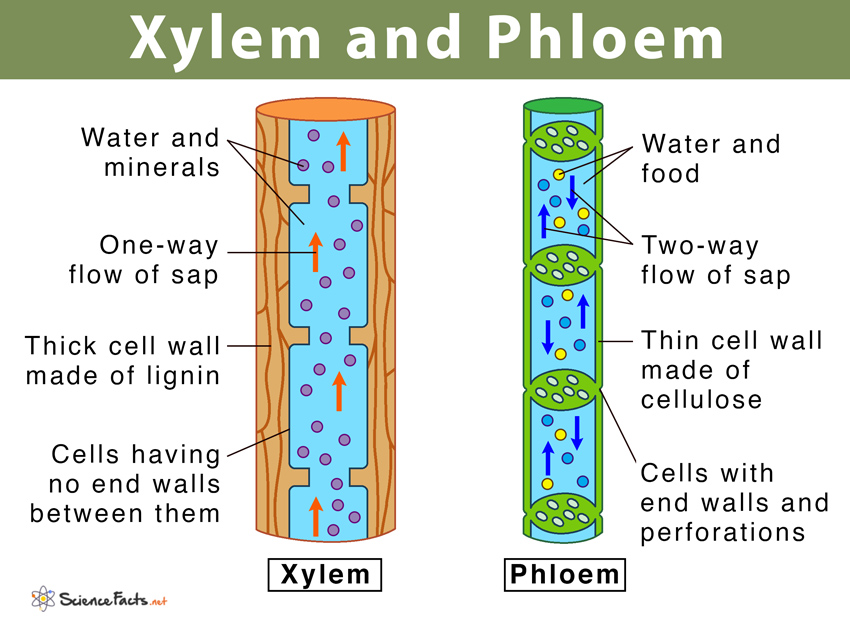
14
New cards
There are three main assumptions about water transport that can be tested by simple experiments:
\
\
1. Water has adhesive properties
2. The cell wall contains small capillaries through which the water moves
3. Evaporation of water leads to tension in the xylem
15
New cards
Experiments that test these three assumptions:
\
\
1. If a glass capillary(hollow) is placed in a bowl of water, the water will slowly be pulled up the capillary. This is not the case if you replace the water with mercury which doesn't have adhesive properties
2. If you dip a strip of paper in water(and the paper is made of cellulose), the water will slowly move up the strip and you will see more and more of the paper getting wet
3. If you take a pot with many small holes, seal it, and put a small tube with water excess through it, you will see the water gradually rising through the tube because the water vapor in the pot will slowly evaporate through the holes and create tension inside the pot.
\
16
New cards
Saline Soil
Soil found in dry climates, where water is evaporated from the soil → leaves behind soil saturated with mineral ions.
17
New cards
Due to the soil’s high solute concentration in saline soil…
* the water would not be able to move through osmosis in most plants → halophytes are plants adapted to saline soils as they keep the solute concentration inside their roots higher than the concentration of the soil
* Halophytes do this by keeping a high concentration of potassium sugars in their cytoplasm
* In the vacuoles, they can keep high levels of Na+ since there are no metabolic processes going on there → there is an active excretion of sodium out of the plant
* In this way, halophytes maintain a high ion concentration so that the little water from the soil still enters the plant by osmosis
* Halophytes do this by keeping a high concentration of potassium sugars in their cytoplasm
* In the vacuoles, they can keep high levels of Na+ since there are no metabolic processes going on there → there is an active excretion of sodium out of the plant
* In this way, halophytes maintain a high ion concentration so that the little water from the soil still enters the plant by osmosis
18
New cards
In dessert areas,
Xerophytes are plants adapted to live in dry habitats.
* Cacti are examples of xerophytes and they thrive in desert environments
\
* Cacti are examples of xerophytes and they thrive in desert environments
\
19
New cards
how do cacti thrive in the dessert?
* They have a thick waxy cuticle that prevents excessive water loss
* Their stems are very upright, so that the largest parts of the stems are only exposed to sunlight in the morning and evening(when the sun is not straight above them) when the heat is less extreme
* Their stomata have the so-called CAM physiology → allows them to close during the daylight and open at night, which is the opposite of what happens in normal plants(recall that stomata are needed for gas exchange during photosynthesis that occurs in the daylight hours)
* The areas of their leaves are reduced so the cacti have spines instead of true leaves to reduce water evaporation
\
* Their stems are very upright, so that the largest parts of the stems are only exposed to sunlight in the morning and evening(when the sun is not straight above them) when the heat is less extreme
* Their stomata have the so-called CAM physiology → allows them to close during the daylight and open at night, which is the opposite of what happens in normal plants(recall that stomata are needed for gas exchange during photosynthesis that occurs in the daylight hours)
* The areas of their leaves are reduced so the cacti have spines instead of true leaves to reduce water evaporation
\
20
New cards
potometer
is a device designed to measure the rate of transpiration of plants
The plant is tightly attached to a long capillary tube that has a water source.
There is an air bubble inside the capillary that indicates how much water the plant has taken up.
As the water transpires off of the plant’s leaves, the water is taken up into the capillary, and the bubble moves.
In order to calculate the precise amount of water that was taken up, the measurements should be repeated several times.
\
The plant is tightly attached to a long capillary tube that has a water source.
There is an air bubble inside the capillary that indicates how much water the plant has taken up.
As the water transpires off of the plant’s leaves, the water is taken up into the capillary, and the bubble moves.
In order to calculate the precise amount of water that was taken up, the measurements should be repeated several times.
\
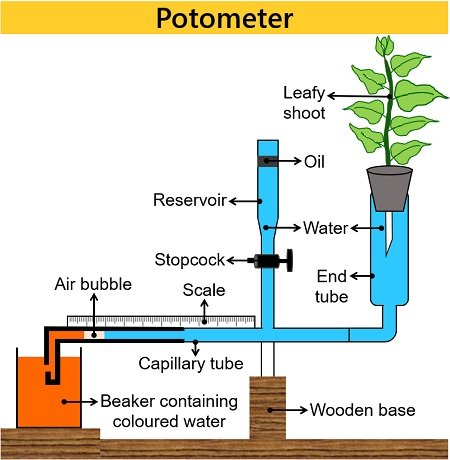
21
New cards
Temperature’s effect on transpiration rate
* Higher temperatures → water molecules evaporate more easily from the surface of the leaves; air molecules around the leaf move faster, so the relative humidity is also lower→ creating a higher gradient for water to move out of the leaf
* At TOO HIGH temperatures: the leaves’ stomata may close and the transpiration decreases slightly.
* Measured using a potometer→ using a heat lamp direced at the plant and a thermometer to measure the leaf temperature
\
* At TOO HIGH temperatures: the leaves’ stomata may close and the transpiration decreases slightly.
* Measured using a potometer→ using a heat lamp direced at the plant and a thermometer to measure the leaf temperature
\
22
New cards
humidity
Refers to the number of water molecules in the air
23
New cards
humidity’s effect on transpiration rate
\
\
* Higher humidity → the smaller the concentration gradient between the moist mesophyll and the humid environment → transpiration decreases
* Measured using potometer→ a plastic bag is placed around the plant so that no air escapes→ by spraying water in the bade or by adding silica bags you can increase/decrease the humidity around the plant → the relative humidity can be measured by using a hydrometer
* Measured using potometer→ a plastic bag is placed around the plant so that no air escapes→ by spraying water in the bade or by adding silica bags you can increase/decrease the humidity around the plant → the relative humidity can be measured by using a hydrometer
24
New cards
Wind’s effect on transpiration rate
* If the air around the leaf is still, the water vapor in the air will not move far away from the leaf and the humidity will increase.
* The higher the wind speed, the lower the humidity will be around the leaf, and the higher the transpiration rate.
* At too high wind speed → stomata may close
* Measured using a potometer→ an electric fan can produce the movement of air around the plant and velocity can vary by moving the fan closer or further away from the plant→ an anemometer is used to measure the exact speed of air movement
\
* The higher the wind speed, the lower the humidity will be around the leaf, and the higher the transpiration rate.
* At too high wind speed → stomata may close
* Measured using a potometer→ an electric fan can produce the movement of air around the plant and velocity can vary by moving the fan closer or further away from the plant→ an anemometer is used to measure the exact speed of air movement
\
25
New cards
phloem
is the vessel transporting organic compounds within the plant, a term often substituted by the term phloem sieve tube
\
\
26
New cards
source
(in the phloem) constitutes photosynthtic tissue(ie. leaves)
\
\
27
New cards
sink
(in the phloem) constitutes organs of storgate of organic material(ie. fruits, roots) \n
\
\
28
New cards
structure of the phloem
is made of live cells that brak down their nucleus and most of the organelles
The walls in between the cells fcontain many holes called the sieve plate, which both help maintain the structure of the tube, and allow for sap to pass through either direction
\
The walls in between the cells fcontain many holes called the sieve plate, which both help maintain the structure of the tube, and allow for sap to pass through either direction
\
29
New cards
The membrane of phloem cells:
\
\
* contains many protein pumps that load and unload sucrose
* also contains plasmodesmata→ tight connections between the phloem cells and the companion cells in the vicinity to mediate exchange of materials
\
* also contains plasmodesmata→ tight connections between the phloem cells and the companion cells in the vicinity to mediate exchange of materials
\
30
New cards
the function of the phloem
brings organic molecules to all parts of the plant
\
\
31
New cards
the “sources of the plant”
The photosynthetic parts of the plant produce organic “food” molecules
* In the _→ sucrose is being loafers into the phloem through active transport. This is because the phloem tube is highly concentrated in organic molecules.
\
* In the _→ sucrose is being loafers into the phloem through active transport. This is because the phloem tube is highly concentrated in organic molecules.
\
32
New cards
sinks
are the storage parts of the plants, such as the roots, tuber, or fruits
\
this is where the sucrose gets unloaded from the phloem. Companion cells exist between bothering the source and the sieve tube→ intermediate location for the organic products.
\
\
this is where the sucrose gets unloaded from the phloem. Companion cells exist between bothering the source and the sieve tube→ intermediate location for the organic products.
\
33
New cards
Hydrostatic Pressure
the pressure exerted by a fluid is maintained by different solute concentrations in the liquid and surrounding spaces
\
\
34
New cards
what increases hydrostatic pressure
In a plant, the sources are rich in sugars(causing osmosis) the movement of water from the cells surrounding the source, and therefore the xylem, toward the sieve tube
35
New cards
what lowers hydrostatic pressure
At the sources the solute concentrations are low at the sieve tube, as organic molecules are being stored away → water can therefore leave the phloem and enter the surrounding tissues and eventually the xylem
(a pressure gradient between the sieve tubes at sources and sinks. This allows for a constant movement of the sap at the sieve tube from the areas gy the sources toward the area of the sink. → organic molecules are constantly and efficiently being moved from the site of production to the site of storage)
(a pressure gradient between the sieve tubes at sources and sinks. This allows for a constant movement of the sap at the sieve tube from the areas gy the sources toward the area of the sink. → organic molecules are constantly and efficiently being moved from the site of production to the site of storage)
36
New cards
how sucrose is loaded from the source into the phloem
active transport
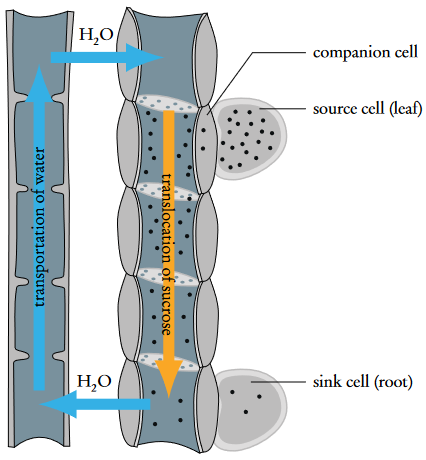
37
New cards
Purpose of a Co-transporter
pumps sucrose into the phloem by making use of a hydrogen ion gradient that is created by a hydrogen protein pump.
* This is a type of secondary active transport, where the co-transporter uses the energy stored in the hydrogen gradient to move the sucrose against its concentration gradient
\
* This is a type of secondary active transport, where the co-transporter uses the energy stored in the hydrogen gradient to move the sucrose against its concentration gradient
\
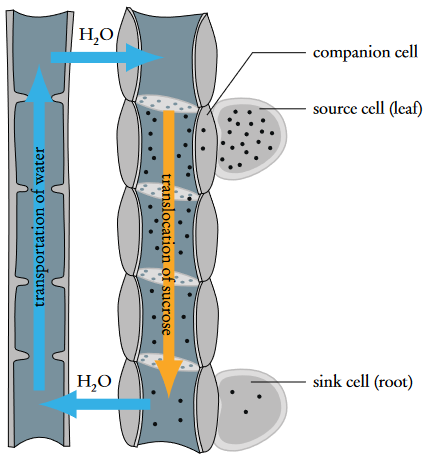
38
New cards
how can companion cells help with active transport
they take sucrose from the source and pass it onto sieve tube
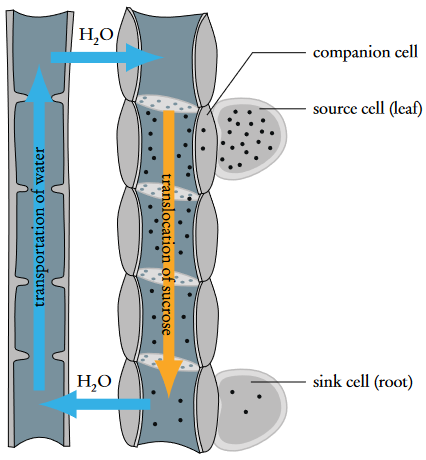
39
New cards
Aphids
small animals that feed on the sap of plants
* they do this by piercing the plant with their stylets until they reach the phloem sieve tube
\
* they do this by piercing the plant with their stylets until they reach the phloem sieve tube
\
40
New cards
Measuring the rate of phloem transport: If scientists supply the plant with CO2 containing radioactive Carbon
the plant makes radioactive sucrose that can then be detected in the phloem
* Once the aphid pierces the phloem, the stylet is cut off, and the sucrose-rich sap that comes out will be collected by the aphid
* The time taken for the radioactive sucrose to move to different parts of the phloem can be used as a measure of phloem transport rate
* Once the aphid pierces the phloem, the stylet is cut off, and the sucrose-rich sap that comes out will be collected by the aphid
* The time taken for the radioactive sucrose to move to different parts of the phloem can be used as a measure of phloem transport rate
41
New cards
Flowers
are the reproductive organs of many plants.
* The stamen constitutes the male organs and the carpel constitutes the female organs
* The stamen constitutes the male organs and the carpel constitutes the female organs
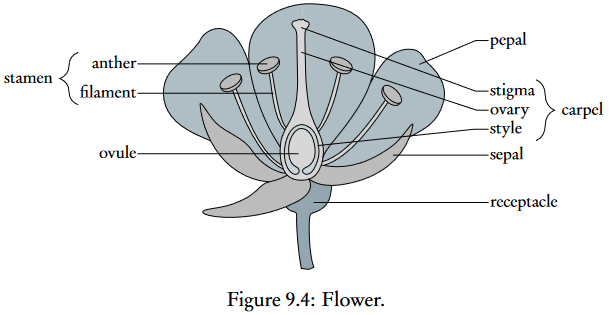
42
New cards
The seed
contains the embryo of a plant and supplies the food and water needed for its development. The seed is made of modified leaves called cotyledons
\
\
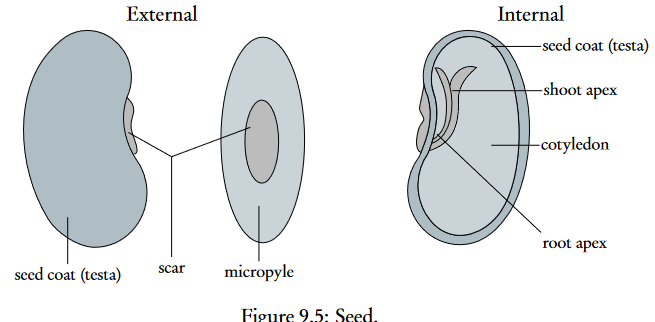
43
New cards
Fertilization
is the process of sygote formation, which occurs through the fusion of male gametes(in polen) and female gametes(in ovule)
44
New cards
Pollination
is the transfer of pollen(containing male gametes) from anthers to the stigma(which contains the female gamete). Pollination occurs as the pollen is transferred to the stigma, where the gametes germinate and grow in a pollen tube to the ovary
45
New cards
Seed Dispersal
this is the process where the seeds containing the plant embryo are dispersed in nature where they germinate and grow. Seed dispersal occurs as the fertilized ovules develop into fruits that contain seeds.
46
New cards
When Short day plants flower
flower during the winter
47
New cards
When long day plants flower
flower during the summer
48
New cards
the length of the dark period
is the factor determines when the plant will flower
\
* Regulated by the molecule called phytochrome that exists in two forms:
* Inactive red form(Pr)
* Active far red form(Pfr)
\
* Regulated by the molecule called phytochrome that exists in two forms:
* Inactive red form(Pr)
* Active far red form(Pfr)
49
New cards
Inactive red form(Pr)
absorbs red light causing it to become Pfr
50
New cards
Active far red form(Pfr)
absorbs far-red light causing it to become Pr
51
New cards
Sunlight contains
more red light than far-red light → during the day Pr gets converted to Pfr, reaching its highest levels of Pfr. At night(absence of sunlight) Pfr reverts back to Pr
52
New cards
Short-day plants(winter flowering)
Pfr inhibits the flowering of the plant, therefore a long night will cause the lowest amounts of Pfr, causing flowering
53
New cards
Long-day plants(summer flowering)
Pfr triggers flowering, therefore shorter nights will cause low amounts of Pfr changing to Pr and an accumulation of Pfr, causing flowering
\
Note:
Plants can be made to flower out of their season by varying the amount of time when they are exposed to light vs. dark
\
Note:
Plants can be made to flower out of their season by varying the amount of time when they are exposed to light vs. dark
54
New cards
### *9.3.2 Mutualism and pollination understandings*
\
\
Most flowering plants depend on insects and other animals for pollination and consequent reproduction. → Mutualistic relationship→ the animal that pollinates the flower feeds on its nectar and in return transfers pollen from one flower to another(or within one plant)
Oftentimes, a specific species of insect interacts with one specific plant
* Ie. there is a species of bee that feeds on vanilla orchid nectar and therefore only pollinates vanilla orchids by crossing from one plant to another in search for food.
\
Oftentimes, a specific species of insect interacts with one specific plant
* Ie. there is a species of bee that feeds on vanilla orchid nectar and therefore only pollinates vanilla orchids by crossing from one plant to another in search for food.
\
55
New cards
Meristems
are the regions of plants containing undifferentiated cells that continuously divide and grow
\
\
56
New cards
Determinate Growth
can be observed in animal species, where the embryo doesn’t grow indefinitely, but has a determined number of legs, arms, organs, etc, to grow
57
New cards
Indeterminate Growth
is seen in plants, where the apical meristem can continually provide new cells for further growth of the plant(ie. meristems)
\
\
58
New cards
Auxin
is a plant hormone that controls growth in the shoot tip, by stimulating of inhibiting cell division, and setting the direction of growth(tropism)
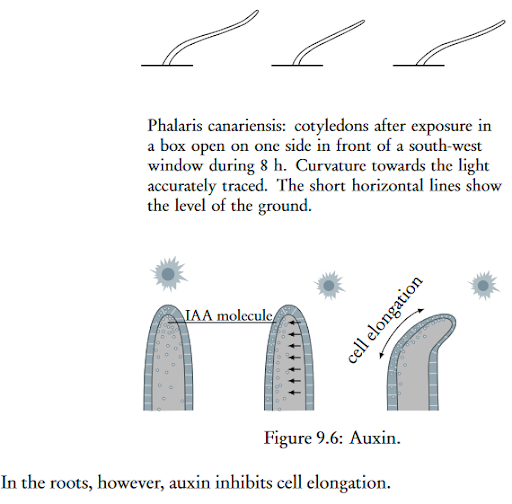
59
New cards
Phototropism
is directional growth guided by the brightest source of light
\
\
60
New cards
Micropropogation
is a term used to describe the propagation of plants(growth) from a single small piece of plant tissue
\
\
61
New cards
Apical meristem
found in the shoots and roots of the plant
* Are responsible for the lengthening of the plant(primary growth) and leaf development
\
* Are responsible for the lengthening of the plant(primary growth) and leaf development
\
62
New cards
Shoot of the plant
s defined as the stem with leaves- the shoot contains the cells of apical meristem which continuously divide
* During these divisions, some of the cells get displaced to the sides of the meristem and therefore stop dividing → instead they grow and differentiate in order tot produce stem and leaf tissues
\
* During these divisions, some of the cells get displaced to the sides of the meristem and therefore stop dividing → instead they grow and differentiate in order tot produce stem and leaf tissues
\
63
New cards
Leaves are produced when
the meristem cells get displaced to the side of the apical meristem and form bumps
* These bumps(AKA Leaf primordia) are differentiated cells that continue to divide and grow until they form fully-grown leaves
\
* These bumps(AKA Leaf primordia) are differentiated cells that continue to divide and grow until they form fully-grown leaves
\
64
New cards
Lateral maristems
are found at the cambium of the plant and are responsible for lateral growth(secondary growth)/thickening of the plant and production of bark in woody plants
65
New cards
phototrophins
are photosensitive pigments in plant shoot cells that respond to different light intensity
* Once activated, the photopigments also activate photon pumps that pump H+ ions into the cell wall
\
* Once activated, the photopigments also activate photon pumps that pump H+ ions into the cell wall
\
66
New cards
In the cytoplamst, auxin
is a negatively charged molecule
* The positive charge of the wall attracts auxin molecules to move towards the wall, where they bind a hydrogen ion and then diffuse into the next cell
\
* The positive charge of the wall attracts auxin molecules to move towards the wall, where they bind a hydrogen ion and then diffuse into the next cell
\
67
New cards
Once in the cytoplasm again, the auxin
loses the H+ ions and becomes negatively charges
It can then move to the next cell, and therefore redistribute to the shadier side of the plant
* Once in the shadier parts of the plant, the auxin binds its receptor and activates genes responsible for the secretion of more H+ ions into the cellulose cell wall
\
It can then move to the next cell, and therefore redistribute to the shadier side of the plant
* Once in the shadier parts of the plant, the auxin binds its receptor and activates genes responsible for the secretion of more H+ ions into the cellulose cell wall
\
68
New cards
With the extra H+ ions in the cell wall
the acidity increases, and the cellulose loosens up, allowing the plant to elongate, which leads to the general movement of the plant towards the light.
* This is because when the cells elongate, they’re causing a bending of the plant towards the opposite direction
* In roots however, the auxin inhibits cell elongation
\
\
* This is because when the cells elongate, they’re causing a bending of the plant towards the opposite direction
* In roots however, the auxin inhibits cell elongation
\
\
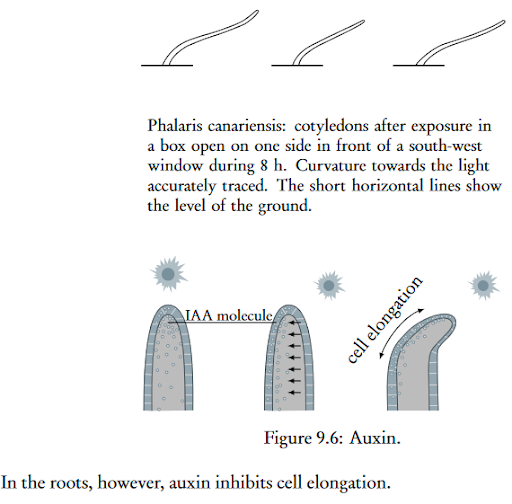
69
New cards
In order for the embryo shoot to emerge from the seed the seed needs to be exposed to optimal conditions such as the following:
\
\
1. Water → to rehydrate the plant seed
2. Oxygen → to start up cell respiration
3. Warmth → to provide optimal temperature for enzyme activity
\
70
New cards
You can test for the effects of water oxygen and warmth on the seed germination by
designing an experiment where two of them are constant and the third is changed.
\
Example:
\
\
\
\
Example:
\
\
\
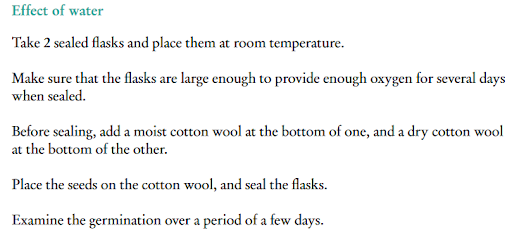
71
New cards
Steps of Micropropagation
1. A small piece of plant tissue is taken from the shoot tip of a plant
2. The piece of tissue is sterilised and placed in a sealed flask containing nutrient rich agar with abundant auxin
3. The plant is allowed to grow into a shapeless lump of tissue called callus which can then be split for extended growth
4. A piece of the callus can be transferred to auxin poor agar, containing other hormones neded for shoot and root development
5. Once the plantlet develops, it can be transferred to soil to continue its growth into a proper plant
\
72
New cards
Advantages of Micropropagation
* Speeds up the process of plant propagation, only uses small amounts of tissue
* The shoot tips re usually virus free
* The costs of plant production is decreased→ they don’t have to be taken from native habitat
\
* The shoot tips re usually virus free
* The costs of plant production is decreased→ they don’t have to be taken from native habitat
\